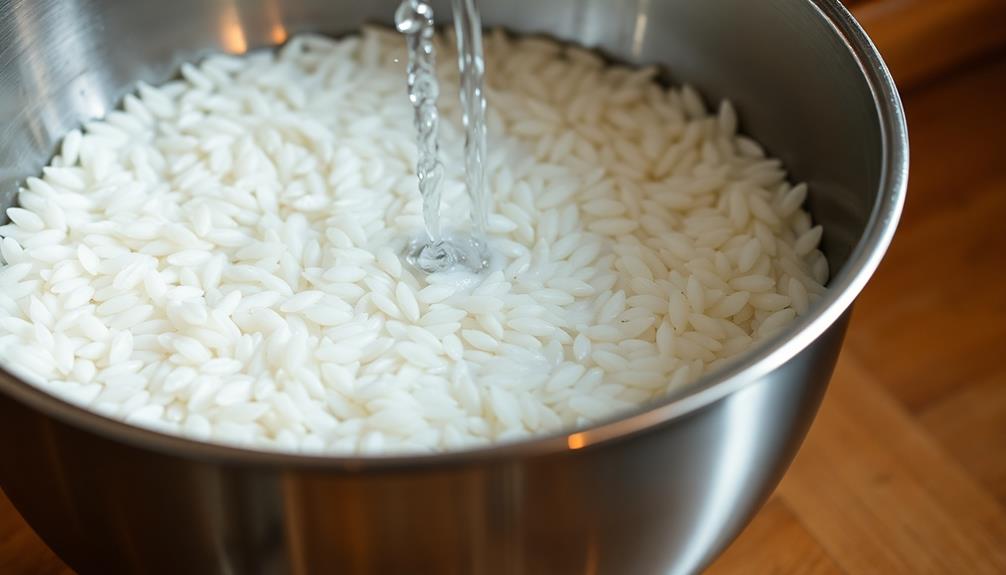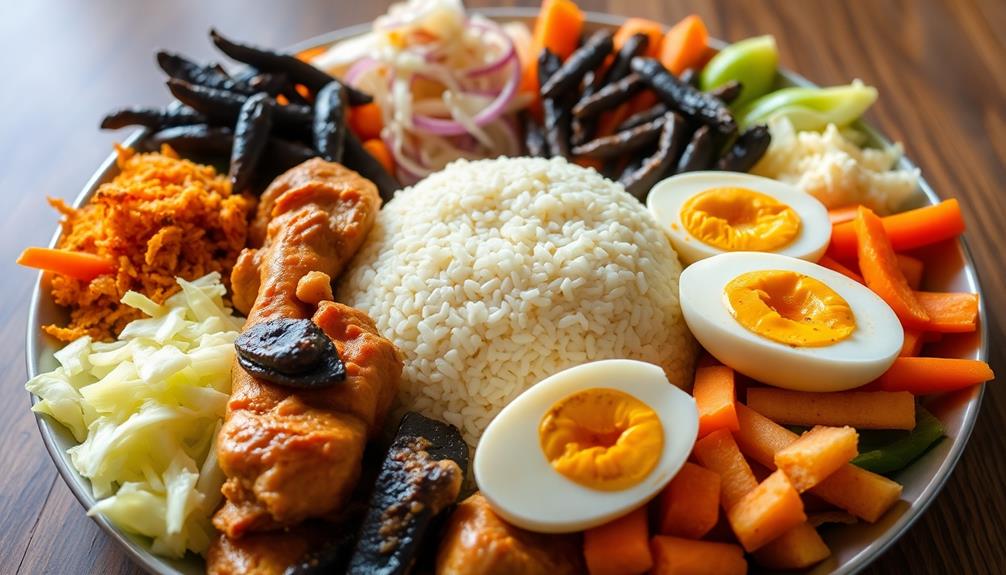Explore the vibrant flavors of Nasi Campur, a beloved rice dish from Southeast Asia! This culinary gem blends fragrant rice with an array of proteins, vegetables, and flavorful accompaniments, reflecting the diverse culinary traditions of the Malay Archipelago. You'll discover a symphony of savory, spicy, and sweet notes in every bite, inviting you to customize the dish to your liking. Journey through the rich history and cultural significance of this beloved dish, which brings people together around the table. There's more to uncover about this captivating culinary experience. Elevate your Nasi Campur experience with a tantalizing coconut rice recipe, adding a touch of creamy richness to complement the vibrant flavors. This aromatic and indulgent twist on the classic rice dish will take your taste buds on a delightful journey. Embrace the culinary traditions of Southeast Asia and savor the harmonious blend of ingredients in every spoonful of Nasi Campur.
Key Takeaways
- Nasi Campur is a vibrant rice dish originating from the Malay Archipelago, reflecting the region's diverse culinary heritage and cultural influences.
- The dish combines fragrant rice with various proteins, vegetables, and condiments, offering a symphony of flavors and textures.
- Nasi Campur is a customizable dish, allowing for personal adjustments to suit individual tastes and preferences.
- The dish is often served during special occasions or communal dining, encouraging sharing and interaction among diners.
- Nasi Campur represents the art of balancing flavors and textures, perfected over generations in traditional Javanese rice dishes.
History
Nasi Campur, the beloved Indonesian dish, can be traced back to the rich culinary tapestry of the Malay Archipelago. Over centuries, this vibrant region's diverse cultures and trading routes have blended flavors and ingredients, creating a melting pot of gastronomic delights.
Nasi Campur's origins are rooted in the traditional Javanese rice dishes, which often combined various side dishes, meats, and vegetables. As traders and settlers from across the archipelago arrived, they introduced new spices, cooking techniques, and ingredients that further enriched the dish.
The result is a harmonious symphony of flavors, where the aromatic coconut rice serves as the foundation for an array of savory toppings, each contributing its unique taste and texture.
Today, Nasi Campur remains a beloved staple, embraced by locals and travelers alike, as it showcases the diversity and culinary artistry that define the Indonesian culinary landscape.
Recipe
Nasi Campur, a vibrant and flavorful Indonesian rice dish, is a beloved staple that brings together an array of complementary ingredients. This versatile dish allows for a customizable culinary experience, where each component adds depth and dimension to the overall harmony of flavors.
The foundation of Nasi Campur lies in the carefully prepared steamed rice, which serves as a blank canvas for the array of accompaniments. These accompaniments, ranging from savory meats and vegetables to fragrant spices and condiments, create a symphony of textures and tastes that dance across the palate. In addition to the staple ingredients, Nasi Campur also often includes a variety of side dishes, such as pickles, sambals, and fried crispy shallots. These additional elements add even more depth and complexity to the dish, making each bite a delightful experience. Similar to the traditional jollof rice recipe, Nasi Campur truly encapsulates the essence of Indonesian cuisine, with a harmonious blend of flavors and an emphasis on fresh, high-quality ingredients.
Ingredients:
- 2 cups long-grain white rice
- 1 boneless, skinless chicken breast, cubed
- 1 cup sliced cabbage
- 1/2 cup shredded carrots
- 2 hard-boiled eggs, halved
- 1/4 cup fried shallots
- 2 tablespoons crispy anchovies
- 1 tablespoon sambal oelek (or other chili paste)
- 2 tablespoons kecap manis (sweet soy sauce)
- 1 teaspoon ground coriander
- 1/2 teaspoon ground cumin
- Salt and pepper to taste
Cooking Instructions:
In a large pot, prepare the steamed rice according to package instructions. While the rice is cooking, sauté the chicken in a skillet until fully cooked.
In a separate pan, lightly sauté the cabbage and carrots until tender-crisp.
Arrange the cooked rice, chicken, cabbage, carrots, hard-boiled eggs, fried shallots, and crispy anchovies on a serving platter. Drizzle the sambal oelek and kecap manis over the dish, and sprinkle the ground coriander and cumin. Season with salt and pepper to taste.
Tips:
For an authentic Nasi Campur experience, consider adding other accompaniments such as fried tempeh, sambal goreng (spicy vegetable stew), and abon (shredded fried meat).
Adjust the spice level by adding more or less sambal oelek to suit your preferences. Serve Nasi Campur warm, allowing your guests to customize their plates with their favorite toppings and condiments.
Cooking Steps
First, rinse and soak the rice to get it ready.
Then, stir-fry the vegetables and protein, adding in your favorite herbs and spices.
Finally, cook the rice and serve the delicious Nasi Campur warm.
Enjoy this flavorful and satisfying dish!
Step 1. Rinse and Soak Rice

Rinsing and soaking the rice is a vital preparatory step in crafting the perfect Nasi Campur. First, place the rice in a fine-mesh strainer and rinse it under cool, running water. Gently swish the grains with your hand to remove any excess starch or impurities. This step ensures the rice cooks evenly and achieves the perfect texture.
Next, transfer the rinsed rice to a bowl and cover it with clean water. Allow the rice to soak for at least 30 minutes, or up to 2 hours. Soaking softens the grains, making them more receptive to absorbing flavors during the cooking process. It also helps the rice cook faster and more consistently.
Once the soaking is complete, drain the rice thoroughly in the strainer. You're now ready to move on to the next step of preparing your delectable Nasi Campur. The perfectly rinsed and soaked rice will be the foundation for a truly memorable meal.
Step 2. Stir-Fry Vegetables and Protein

With the rice prepped and ready, it's time to focus on the flavorful vegetables and protein that will make up the heart of your Nasi Campur. You'll need to gather a variety of fresh, colorful veggies – perhaps some crisp cabbage, juicy tomatoes, and vibrant carrots. Chop them into bite-sized pieces so they'll cook quickly and evenly.
Next, choose your protein, whether it's tender chicken, savory beef, or plant-based tofu. Slice or cube it into small, uniform pieces so it'll sear nicely in the pan.
Heat a generous drizzle of oil in a large skillet or wok over medium-high heat. Once it's shimmering, add your protein and stir-fry until it's lightly browned on the outside but still juicy inside.
Toss in the chopped veggies and continue stir-frying until they're crisp-tender. Season with a splash of soy sauce, a pinch of sugar, and a sprinkle of spices to give the whole mixture a delightful flavor boost.
Now you're ready to assemble your Nasi Campur!
Step 3. Add Herbs and Spices

To lend your Nasi Campur dish even more depth of flavor, you'll want to add a variety of aromatic herbs and spices. Start by including fragrant lemongrass, which adds a citrusy note. Fresh ginger and garlic will provide a warm, pungent kick. For a touch of sweetness, sprinkle in some ground coriander and cumin.
Don't forget to incorporate a pinch of turmeric, which will impart an earthy, slightly peppery taste and vibrant golden color. Herbal teas, known for their unique flavors and potential health benefits, can also inspire your choice of spices and herbs in cooking, particularly those like chamomile that promote relaxation.
Now, let's not forget the spicy factor! A few tablespoons of sambal oelek or other chili paste will bring the heat, while fresh, chopped cilantro and lime wedges will brighten up the dish.
Experiment with these flavors, adjusting the amounts to suit your personal preferences. The key is to create a harmonious blend that tantalizes your taste buds. With these aromatic herbs and spices, your Nasi Campur will truly come alive, transporting you to the vibrant flavors of Indonesia.
Step 4. Cook Rice

Once you've assembled your aromatic ingredients, it's time to turn your attention to cooking the rice. Start by rinsing the rice thoroughly under cold running water. This removes any excess starch, ensuring your rice turns out fluffy and separate, rather than sticky.
Next, add the rinsed rice to a heavy-bottomed pot and cover it with water or broth. For best results, use a 1:2 rice-to-liquid ratio. Bring the pot to a boil over high heat, then immediately reduce the heat to low, cover the pot with a tight-fitting lid, and let the rice simmer for 15-20 minutes.
Resist the urge to lift the lid and stir the rice, as this can release steam and disrupt the cooking process.
Once the time is up, remove the pot from the heat and let it sit, covered, for an additional 5-10 minutes. This allows the rice to finish cooking and the grains to separate perfectly.
Fluff the rice with a fork before serving, and you're ready to assemble your delicious Nasi Campur dish!
Step 5. Serve Nasi Campur Warm

Once you've cooked the rice to perfection, it's time to assemble your Nasi Campur dish.
Start by gathering all your prepared ingredients – the fragrant rice, the savory toppings, and the flavorful sauces. Arrange the components artfully on a plate or in a bowl, letting the vibrant colors and textures create an appetizing display.
Spoon the steaming hot rice into the center of your serving dish. Carefully place the various toppings, such as fried chicken, tempeh, vegetables, and egg, around the rice in an appealing manner.
Drizzle the flavorful sauces, like sambal and kecap manis, over the dish. The warm temperature will allow the aromas to waft up, tantalizing your senses.
Final Thoughts
Culinary exploration is a journey of delightful discoveries, and the final thoughts on the captivating dish Nasi Campur are no exception.
This vibrant and flavor-packed rice dish is a true celebration of Southeast Asian cuisine, inviting you to embark on a sensory adventure. The harmonious blend of fragrant rice, savory proteins, and an array of colorful accompaniments creates a symphony of tastes and textures that dance on your palate.
Whether you're a seasoned foodie or discovering Nasi Campur for the first time, the sheer versatility of this dish is sure to delight. You can easily customize it to suit your personal preferences, making it a wonderful option for family gatherings or intimate meals.
As you savor each bite, you'll be transported to the bustling markets and home kitchens of the region, where the art of Nasi Campur has been perfected over generations.
Dive in and let this culinary gem captivate your senses.
Frequently Asked Questions
Is Nasi Campur Gluten-Free?
Whether a dish is gluten-free depends on its ingredients. Without knowing the specific recipe, I can't definitively say if nasi campur is gluten-free. To determine this, you'd need to check the ingredients used in the particular preparation.
Can Nasi Campur Be Made Vegetarian?
You can absolutely make a vegetarian version of this dish. Simply omit any meat or seafood ingredients and include more plant-based proteins like tofu, tempeh, or legumes. Customize the dish to suit your dietary preferences.
How Long Does Nasi Campur Last in the Fridge?
Homemade dishes like this one generally last 3-4 days in the fridge when stored properly. Be sure to refrigerate it in an airtight container, and reheat thoroughly before enjoying. Nasi campur will maintain its flavor and texture for several days this way.
Is Nasi Campur Suitable for Children?
Absolutely! Nasi campur can be a great and wholesome meal option for children. Just be mindful of any spicy or strongly seasoned components and adjust them to suit your child's taste preferences. Kids will likely enjoy the variety of flavors and textures.
Where Can I Buy the Ingredients for Nasi Campur?
You can find the ingredients for this dish at your local Asian grocery store or supermarket. They'll have all the necessary spices, vegetables, and proteins to make an authentic and delicious nasi campur at home.










